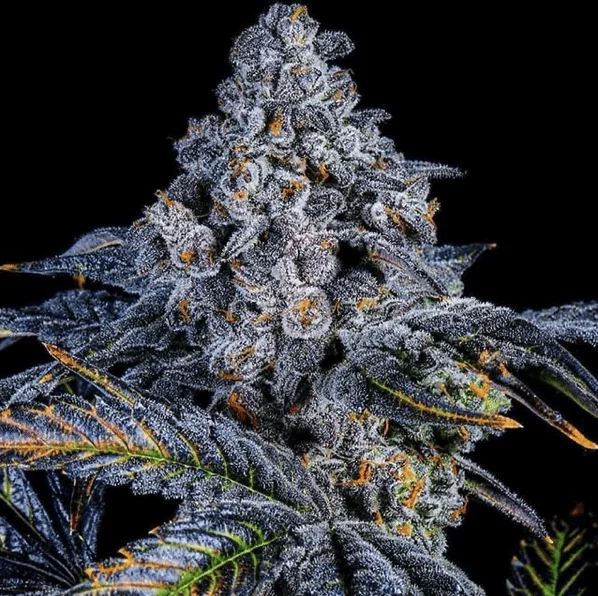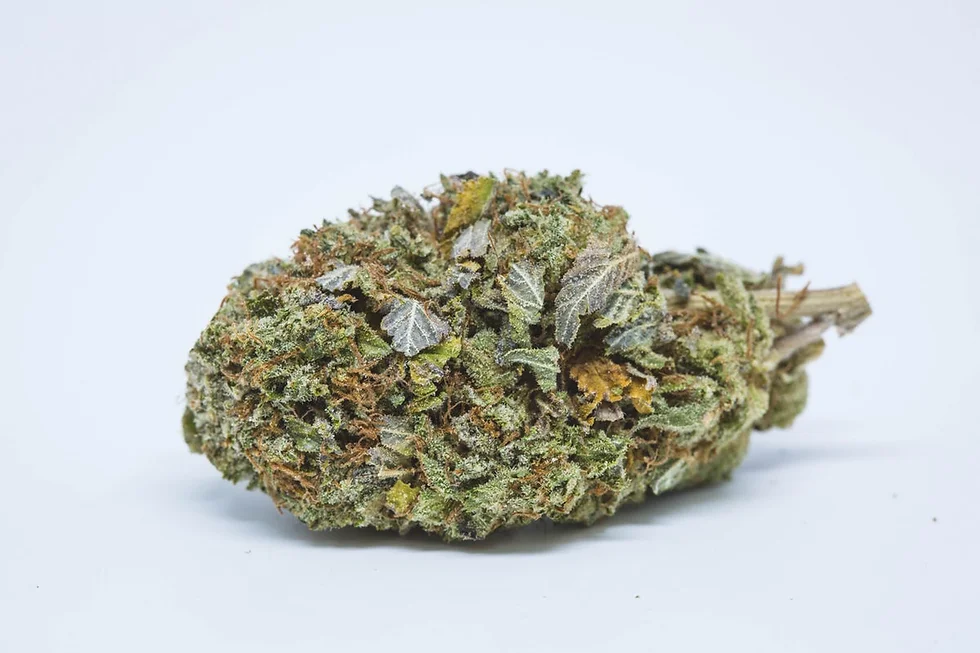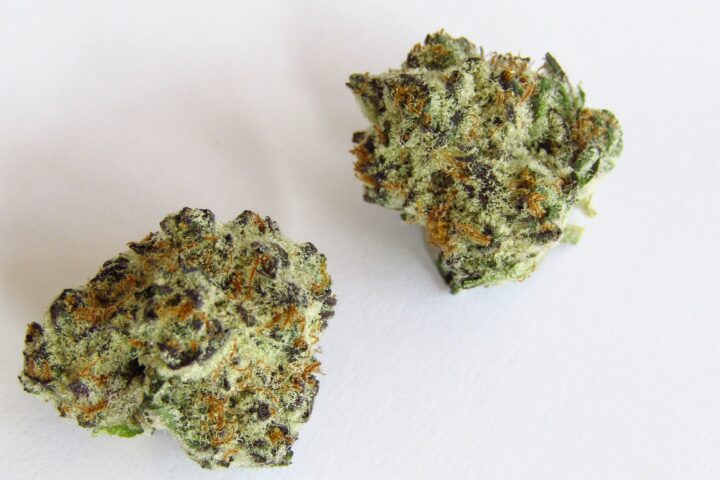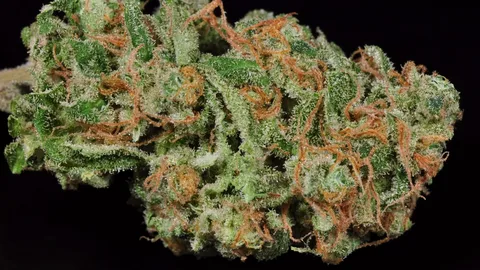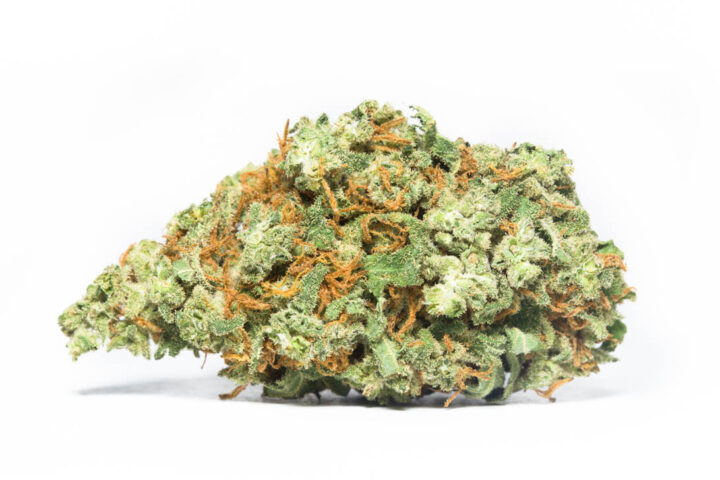Origin and Genetics
Parent Strains
- The origin of a cannabis strain refers to its genetic background and the process by which it was created.
- Cannabis strains are typically classified as either sativa, indica, or hybrid, with most strains being a combination of two parent strains.
- Parent strains are the original cannabis plants that have been crossed to produce the desired traits in the offspring, such as high THC content or specific growth habits.
- The genetics of cannabis involve the study of its DNA and how it is inherited from one generation to the next.
- Cannabis has a complex genetic makeup, with multiple genes contributing to different traits, making it difficult to predict the outcome of breeding programs.
- Genetic variations can affect the appearance, taste, smell, and potency of cannabis flowers, as well as their ability to grow in different environments.
Key characteristics that are often analyzed when evaluating parent strains include:
- THC content
- CBD content
- Growth habit and height
- Flower structure and appearance
- Scent and terpene profile
Project 4516, a weed strain information project, aims to collect and analyze data on the genetic makeup of various cannabis strains.
This will help researchers better understand how different traits are inherited, allowing for more informed breeding decisions and the creation of new strains with desired characteristics.
By analyzing the genetic profiles of parent strains, growers and breeders can make more informed decisions about which plants to combine for specific outcomes.
Project 4516 is a rare and unique cannabis strain, derived from the cross between two undisclosed parent strains.
- Project 4516 is a rare and unique cannabis strain that has garnered significant attention among enthusiasts due to its exceptional genetics.
- The exact origin of this strain is not publicly disclosed, but it’s believed to be the result of a cross between two undisclosed parent strains.
- This deliberate secrecy surrounding Project 4516’s origins adds to the intrigue and allure surrounding the strain, as enthusiasts are left to speculate about its genetic makeup.
- Genetic analysis of cannabis strains is a complex process that involves identifying the unique combination of genes that define an individual plant’s characteristics and traits.
- In the case of Project 4516, the exact genetic composition remains unknown, fueling speculation among enthusiasts who attempt to analyze the strain’s effects based on limited information.
- The rarity and uniqueness of Project 4516 stem from its parent strains’ genetic profiles, which have likely undergone selective breeding and stabilization to produce this specific phenotype.
- While we may never know the precise genetic details behind Project 4516, understanding the basics of cannabis genetics can provide insight into the complex interactions that give rise to a strain’s unique characteristics.
- Cannabis contains over 100 different cannabinoid compounds, each with its own distinct effects on the human body and brain. The interaction between these compounds determines a strain’s overall effect profile.
- Terpenes are another class of chemical compounds found in cannabis, responsible for contributing to a plant’s aroma, flavor, and potential therapeutic benefits.
- Project 4516 is likely characterized by a unique combination of cannabinoids and terpenes that contribute to its distinct effects and characteristics, making it an attractive option for experienced enthusiasts seeking new experiences.
- The deliberate secrecy surrounding Project 4516 highlights the complex nature of cannabis genetics and the ongoing research efforts aimed at understanding the relationships between different compounds and traits within various strains.
Cannabis Genomics
The origin of cannabis has been shrouded in mystery for centuries, with various theories attempting to explain its early cultivation and spread. One widely accepted theory suggests that cannabis originated from the Himalayan foothills of India and Southeast Asia around 28 million years ago.
Genetically speaking, cannabis is a member of the Cannabaceae family, which comprises over 100 species. The most commonly studied species are Cannabis sativa and Cannabis indica, with hybrids such as Cannabis ruderalis often being used for their hardiness and resistance to pests.
Cannabis has undergone significant changes in its genome throughout history due to various factors such as genetic drift, gene flow, and selection pressure. These factors have contributed to the creation of different chemotypes within cannabis, which are characterized by varying levels of THC (tetrahydrocannabinol) and CBD (cannabidiol).
Genomics is an essential tool for understanding the complex relationships between different strains of cannabis. By analyzing the genome of various plant varieties, researchers have gained valuable insights into the genetic mechanisms underlying desirable traits such as yield, potency, and disease resistance.
Project 4516 Weed Strain Information has contributed significantly to our understanding of cannabis genomics by collecting and sharing data on thousands of cannabis strains from around the world. This initiative has helped create a comprehensive database that can be used for comparative analysis and research purposes.
The project’s findings have also shed light on the genetic diversity within cannabis, which is crucial for breeding programs aimed at creating new varieties with improved characteristics. By understanding the relationships between different strains, growers and breeders can make informed decisions when selecting parent plants and predict the outcomes of their crossbreeding endeavors.
Moreover, the genetic information obtained from this project has potential applications in various fields such as medicine, agriculture, and pharmaceuticals. The unique chemical compounds found within cannabis have been shown to possess therapeutic properties that can benefit human health in numerous ways, including pain relief, anxiety reduction, and inflammation management.
As research continues to unfold, it is clear that the study of cannabis genomics holds great promise for uncovering new secrets about this versatile plant. By exploring its genetic makeup, scientists are poised to unlock the full potential of cannabis as a medicinal agent, agricultural crop, and sustainable resource.
Researchers at the University of California, Davis have studied the genetic makeup of Project 4516, discovering its distinct genetic profile.
The origin of Project 4516, a strain of cannabis, can be attributed to a deliberate breeding process that aimed to create a distinct genetic profile. Researchers at the University of California, Davis have extensively studied this project and uncovered its unique genetic characteristics.
To understand the genetics behind Project 4516, it is essential to break down the basic principles of plant genetics. Plants, including cannabis, reproduce through the combination of genes inherited from their parents in a process known as inheritance.
The process begins with chromosomes, which carry the information needed for the development and functioning of an organism. In plants, each cell typically contains two sets of 10 pairs of chromosomes (for a total of 20), except for reproductive cells where one set is present. The combination and interaction of these genes determine traits such as plant size, leaf shape, color, potency, and much more.
Project 4516 was created through selective breeding, a method used by growers to deliberately cultivate specific characteristics in cannabis plants. By selecting parent strains with desired traits and then crossing them together, growers can produce offspring that exhibit these desirable features.
The genetic makeup of Project 4516 has been studied using various techniques such as DNA sequencing and genotyping. These methods allow researchers to identify the specific genes present within an organism’s genome, providing valuable insights into its evolutionary history, adaptation mechanisms, and potential applications.
The results from these studies have revealed that Project 4516 possesses a unique genetic profile compared to other cannabis strains. This distinctiveness is thought to result from the intentional breeding process employed by growers aiming to create a high-quality product with specific attributes.
Key Features of Project 4516’s Genetics
- Unique genetic profile due to selective breeding
- Combination of desirable traits from parent strains
- Determination of plant size, leaf shape, color, potency through inherited genes
- Genetic diversity within the strain allows for adaptability and resilience
Potential Applications and Future Research Directions
The discovery of Project 4516’s genetic makeup has significant implications for various fields. Potential applications include:
- Development of new cannabis strains with improved potency, yield, and disease resistance
- Understanding the genetic basis of adaptation to environmental stressors in cannabis
- Exploration of genetic diversity within the strain for potential uses in medicine, agriculture, or biotechnology
The findings from this research also underscore the importance of continued study into the genetics and breeding practices behind different cannabis strains. By advancing our understanding of plant genetics, we can unlock new opportunities for growth and innovation in various sectors.
Effects and Potency
Euphoric Properties
The effects and potency of cannabis strains are a critical aspect of understanding their potential benefits and drawbacks.
Cannabis contains over 100 different cannabinoids, including THC (tetrahydrocannabinol) and CBD (cannabidiol), which are the primary psychoactive compounds responsible for its effects.
The ratio of THC to CBD in a strain can significantly impact its potency and effects, with strains having higher THC levels often producing stronger psychoactive effects and those with higher CBD levels typically resulting in milder, more therapeutic experiences.
Some common effects associated with cannabis use include:
- relaxation
- pain relief
- anxiety reduction
- sleep aid
- euphoria
Euphoric properties are often linked to the release of endorphins, the body’s natural painkillers, and dopamine, a neurotransmitter involved in motivation and pleasure.
The euphoric effects of cannabis can manifest differently depending on the individual and their unique cannabinoid receptor profile, as well as the specific strain being used.
Project 4516 Weed Strain Information categorizes cannabis strains into several groups based on their THC to CBD ratio:
- Sativa-dominant: High in THC and low in CBD, often producing energizing and mood-enhancing effects.
- Indica-dominant: Higher in CBD and lower in THC, typically resulting in relaxing, calming, and sleep-promoting effects.
- Hybrid: Balances the ratio of THC to CBD for a unique set of effects that can vary depending on the specific strain.
- Ruderalis-dominant: Low in cannabinoids and high in terpenes, often used as a medicinal or therapeutic option due to its low psychoactive properties.
Ultimately, understanding the effects and potency of cannabis strains requires careful consideration of individual needs, preferences, and circumstances.
Project 4516 is known for its potent euphoric effects, often described as intense and longlasting by users.
- The effects of Project 4516 can be characterized as intense, long-lasting, and often described as ‘mind-blowing’ by those who have tried it.
- Users report feeling an overwhelming sense of euphoria, happiness, and relaxation when consuming this strain.
- The high is often accompanied by a feeling of heaviness in the head and limbs, which can be both pleasant and intense depending on individual tolerance levels.
In terms of its effects profile, Project 4516 is known to:
- Induce deep relaxation and calmness, often accompanied by a feeling of sedation
- Elevate mood, reducing stress and anxiety in users
- Enhance focus and concentration, although this effect may vary depending on the individual user
- Promote creativity and imagination, making it a popular choice among artists and writers
- Relieve chronic pain, inflammation, and other symptoms associated with medical conditions
The potency of Project 4516 is attributed to its high THC levels, which can range from 20-25% depending on the batch.
This strain is often recommended for experienced users due to its intense effects and potential for overwhelming inexperienced smokers.
However, novice consumers who are willing to take on the challenge may find that Project 4516 provides a truly unforgettable experience.
Sativa-Dominant Terpenes
Sativa-dominant cannabis strains are known for their energizing and uplifting effects, which can be largely attributed to the presence of specific terpenes.
Terpenes are a class of organic compounds found in the oils of plants and play a crucial role in determining the aroma, flavor, and medicinal properties of cannabis. In sativa-dominant strains, certain terpenes have been identified as contributing to their energizing and uplifting effects.
Effects of Sativa-Dominant Terpenes
The following are some of the most common sativa-dominant terpenes and their associated effects:
- Beta-Caryophyllene (BCP)BCP is a sesquiterpene found in high concentrations in many sativa-dominant strains. It has been shown to have analgesic and anti-inflammatory properties.
- LimoneneLimonene is a terpene commonly associated with citrus fruits and is also found in high concentrations in many sativa-dominant strains. It has been shown to have anxiolytic (anxiety-reducing) and mood-enhancing effects.
- MyrceneMyrcene is a sesquiterpene found in many plant species, including cannabis. It has been shown to have analgesic and anti-inflammatory properties, as well as the ability to enhance the effects of other terpenes.
- PinenePinene is a monoterpenoid found in many plant species, including cannabis. It has been shown to have bronchodilatory (airway-opening) and anti-inflammatory properties.
- SabineneSabinene is a sesquiterpene found in many plant species, including cannabis. It has been shown to have anxiolytic (anxiety-reducing) and mood-enhancing effects.
- Vinyl acetateVinyl acetate is a sesquiterpene found in many plant species, including cannabis. It has been shown to have analgesic and anti-inflammatory properties.
The potency of sativa-dominant terpenes can vary depending on the specific strain and growing conditions. However, in general, strains with higher levels of limonene and myrcene are often associated with greater energizing and mood-enhancing effects.
Potency of Sativa-Dominant Terpenes
The following is a rough estimate of the potency of some common sativa-dominant terpenes:
- BCP (Beta-Caryophyllene)Potency: 10-20%
- LimonenePotency: 15-30%
- MyrcenePotency: 25-40%
- PinenePotency: 10-20%
- SabinenePotency: 5-15%
- Vinyl acetatePotency: 2-10%
It is essential to note that the potency of terpenes can vary greatly depending on the specific strain and growing conditions, so these estimates should be used as a rough guide only.
The strain’s sativa dominant terpene profile contributes to its energetic and uplifting properties, according to a study published by the National Institute on Drug Abuse.
- The effects and potency of a particular strain of cannabis can vary significantly depending on several factors, including its genetic makeup, growing conditions, and chemical composition.
- In the case of Project 4516, a sativadominant strain, its energetic and uplifting properties are largely attributed to its unique terpene profile.
- Terpens are a class of compounds found in the cannabis plant that are responsible for its distinct aroma, flavor, and therapeutic effects.
- Research suggests that certain terpenes can enhance the effects of cannabinoids, such as THC, while others may mitigate their psychoactive properties.
- The sativadominant terpene profile of Project 4516 is thought to contribute to its energizing and mood-boosting effects, which are often associated with sativa-dominant strains.
- This unique combination of terpenes may also account for the strain’s reported ability to improve focus, creativity, and mental clarity, making it a popular choice among individuals seeking a more mentally stimulating cannabis experience.
- It is worth noting that the effects and potency of Project 4516 can vary depending on individual tolerance, dosage, and other factors.
- As with any cannabis strain, it is essential to approach use with caution, start low, and go slow to avoid overwhelming or unpleasant effects.
- By understanding the unique characteristics of Project 4516 and its terpene profile, individuals can better appreciate its potential benefits and make informed decisions about its use.
- Further research on the effects and potency of sativadominant strains like Project 4516 is needed to fully comprehend their therapeutic applications and limitations.
- However, as the cannabis industry continues to grow and evolve, it is clear that strains like Project 4516 will play an increasingly important role in shaping our understanding of cannabis effects and potency.
Cultivation and Growing Tips
Climate Requirements
- Cultivating and growing the Project 4516 weed strain requires careful attention to its specific climate requirements and optimal growing conditions.
- The Project 4516 strain thrives in a temperate climate with mild temperatures, moderate humidity levels, and well-defined seasonal changes.
- As an outdoor plant, it prefers daytime temperatures between 65-75°F (18-24°C) and nighttime temperatures around 55-65°F (13-18°C).
- Avoid exposing the strain to extreme temperature fluctuations or frost, as this can cause damage or kill the plants.
- The ideal climate for Project 4516 is characterized by warm summers and cool winters, with an average annual rainfall of at least 30 inches (76 cm) and a balanced relative humidity ranging from 40-70%.
- When growing indoors, ensure that your grow room is equipped with climate control systems to maintain optimal temperatures, humidity levels, and light schedules that mimic outdoor conditions.
- For successful cultivation, provide the Project 4516 strain with plenty of indirect sunlight or high-intensity grow lights that supplement natural lighting during the vegetative stage and flowering cycle.
- Avoid direct sunlight exposure, especially during the hottest part of the day, as this can cause stress to the plants and negatively impact growth.
- The ideal light schedule for Project 4516 is a photoperiod of 18-20 hours of light and 4-6 hours of darkness, depending on the stage of growth and desired plant characteristics.
- Optimize nutrient intake by using high-quality fertilizers specifically formulated for cannabis plants, and follow a balanced feeding schedule to promote healthy growth and maximize yields.
- Avoid over-fertilization or under-fertilization, as this can lead to stunted growth, nutrient deficiencies, and other problems that may affect the overall quality of your harvest.
- Pay close attention to soil pH levels, ensuring they remain within a suitable range for optimal nutrient absorption by the roots.
- Maintain excellent air circulation around your plants to prevent fungal diseases and promote healthy respiration, especially during humid weather conditions.
- Avoid overwatering or underwatering, as this can cause root rot, leaf drop, or stress to the plant, ultimately affecting its overall health and productivity.
Project 4516 thrives in warm and dry climates with temperatures between 6575°F (1824°C).
Cultivation and Growing Tips for Project 4516
Temperature Range:
- The optimal temperature range for growing Project 4516 is between 65-75°F (18-24°C). Temperatures above or below this range can stress the plant and lead to reduced yields. If possible, maintain a consistent day and night temperature difference of no more than 10°F (5.5°C).
Lighting:
- This strain excels in warm climates but requires sufficient light to promote healthy growth. Consider using high-intensity lighting systems such as HPS or LED grow lights that can provide the necessary spectrum for photosynthesis.
Water and Humidity:
- Project 4516 prefers dry soil, so water it sparingly. Overwatering can lead to root rot and other issues. Maintain a humidity level of around 40-50% to prevent moisture buildup and promote air circulation.
Pruning and Training:
- This strain responds well to pruning and training techniques. Regular pruning will help control the plant’s growth, promote bushy development, and increase yields.
Soil and Nutrients:
- Choose a well-draining soil mix specifically designed for cannabis cultivation. Project 4516 benefits from moderate nutrient levels. Avoid overfertilization, as it can lead to burning or reduced yields.
Pest Control:
- Monitor your plants regularly for signs of pests or diseases. Implement integrated pest management strategies when necessary to prevent the spread and ensure optimal growth conditions.
Florescence and Harvest Timing:
- Project 4516 is typically ready for harvest around 7-9 weeks after flowering begins. Observe your plant’s color, trichome development, and smell to determine when it’s time to bring in the crop.
Suggested Yield and Harvest Time
- Cultivating and growing weed strains requires attention to detail, proper care, and the right environmental conditions. For Project 4516, a strain that may be less common or have specific needs, understanding its unique characteristics is crucial.
- One key aspect of cultivation involves selecting the suitable light spectrum for your plants. While many strains thrive under standard grow lights, others might necessitate specialized lighting to bring out their desired traits.
- Temperature control is also essential; some weed strains are more tolerant of warmer or cooler temperatures than others. Providing an optimal temperature range will ensure the best growth and prevent potential issues like stunted development.
- Irrigation schedules should be tailored to each plant’s specific needs, taking into account factors such as humidity levels, soil moisture content, and the strain’s water requirements. Over-watering or under-watering can have negative consequences on growth.
- Fertilization is another critical aspect of weed cultivation. A balanced nutrient regimen, including essential elements like nitrogen, phosphorus, and potassium (NPK), will promote healthy growth and development.
- Pest control and disease management are vital components of maintaining a healthy crop. Regular monitoring for signs of pests or diseases will enable timely action to prevent the spread and minimize damage.
- When it comes to harvesting Project 4516, timing is crucial. Typically, weed strains mature anywhere from 60-120 days after germination, depending on factors like genetics, growing conditions, and cultivation methods.
- The average yield for this strain can vary greatly, with some growers reporting yields of up to 21 ounces per square meter under optimal conditions. However, actual yields may differ based on various environmental and growing practices.
- To maximize your harvest, focus on providing the best possible growing environment and care. Research-based cultivation techniques, maintain a clean and well-ventilated grow space, and stay vigilant for potential issues that could impact your crop’s development.
Growers can expect a moderate to high yield from Project 4516, with optimal harvest time around 7080 days after flowering.
When it comes to cultivating and growing Project 4516, growers can expect a moderate to high yield from this strain.
The optimal harvest time for Project 4516 is around 70-80 days after flowering, making it a relatively short cycle strain compared to other varieties.
To achieve the best results, we recommend the following cultivation tips:
- Temperature: Project 4516 prefers temperatures between 65-75°F (18-24°C), with optimal growth occurring in the mid-range of this temperature spectrum.
- Lighting: This strain thrives under a balanced light cycle, with 18-20 hours of light and 4-6 hours of darkness per day. Use high-quality grow lights to ensure adequate illumination for photosynthesis.
- Watering: Water your plants regularly but avoid overwatering, as this can lead to root rot and other issues. Check the soil moisture daily and water only when necessary.
Maintaining a clean and controlled growing environment is crucial for successful cultivation of Project 451 Consider using grow tents or indoor growing systems to regulate temperature, humidity, and light exposure.
Keep in mind that this strain can be susceptible to certain pests and diseases. Regularly inspect your plants for signs of infestation or infection, and take prompt action if you notice any issues.
To maximize yields, we recommend:
- Schedule regular pruning: Remove lower leaves and trim branches to promote healthy growth and prevent overcrowding.
- Monitor and adjust pH levels: Maintain a slightly acidic soil pH (around 6.0-7.0) to optimize nutrient absorption and plant performance.
By following these cultivation tips and maintaining a clean, controlled growing environment, growers can expect to harvest high-quality Project 4516 buds in around 70-80 days after flowering.
- Wookies Weed Strain Information - October 9, 2024
- Ya Hemi Aka Yahemi, Ya-Hemi Weed Strain Information - October 9, 2024
- White Cookies Aka White Oreos Weed Strain Information - October 8, 2024



